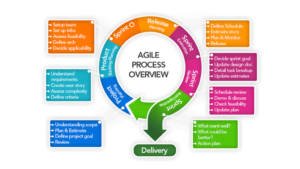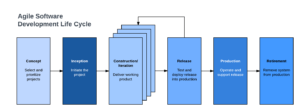Introduction
The agile software development lifecycle is a process that helps businesses create high-quality software products in a shorter amount of time. This process is designed to be flexible and adaptable so that businesses can respond quickly to changes. Agile software development is a method that encourages incremental delivery and client interaction. Agile developers produce functional software early and frequently by working in short cycles known as sprints. At the conclusion of each sprint, the Agile Software Development Lifecycle (ASDLC) provides outcomes.
The various 6 stages of an agile software development lifecycle
Concept
This phase of an agile software development lifecycle facilitates the team in becoming comfortable with the undertaking, understanding the goals and vision of the client, and evaluating potential risks. Typically, this is accomplished before the meeting.
Inception
In the agile software development lifecycle, the team develops high-level requirements and a product roadmap during the inception stage. A product backlog, or a list of all the features that need to be added to the product, is also created during this stage.
Iteration 0 or Set-up
At this point, the essential infrastructure and the development environment have been set up. The team also decides on the procedures to be followed and the equipment to be employed.
The following actions are carried out during the development or iteration phase:
- The connection between the team and its clients.
- Functionalities and iterations are given top priority and put into action.
- A thorough analysis and development should go into each sprint or iteration.
- Delivering frequent releases of functional software.
- Ensuring product quality through routine testing.
Release
The software product is made accessible to the user during the release stage. Depending on the preference of the customer, this can be done either internally or externally.
Additionally, this stage permits ongoing updates and enhancements based on user feedback. Training is provided to customers and users on how to utilize the software. And after everything is finished, the product is put into production.
Maintenance
In this agile software development phase, the team offers assistance and corrects any faults that can be identified in the software product during the maintenance stage. Depending on the product, this stage may never finish.
Retirement
A system may be terminated because it is replaced by new software or because it has outlived its purpose or become incompatible with the organization. The program will first be retired after notifying users. Users will be moved to the most recent system when it is replaced. Steadily for the past but not least, the developers will complete the last tasks and stop providing support for the outdated program. Agile uses several iterations to improve deliverables and produce outstanding results.
Why should to consider using an agile software development lifecycle for the project?
Agile software development methodologies place a strong emphasis on cooperation between developers and stakeholders and are designed to be changeable. An excellent strategy for projects with complicated needs is agile software development. Agile methodologies can speed up the delivery of features and improve your ability to adapt to changes. There are a few considerations you should make if you’re thinking about implementing agile software development for your upcoming project.
First, developers and stakeholders must work closely together to implement agile approaches. Second, agile methods are made to be flexible to change, so be ready to adjust your plans as the project moves forward. Finally, while agile methods might speed up the delivery of features, they may also necessitate more advanced planning than conventional techniques. You will be well on your way to successful agile software development if you keep these things in mind.
How can the agile software development lifecycle benefit business?

Businesses can complete software development projects fast and effectively by using the Agile Software Development Lifecycle (ASDLC). Because the ASDLC is an iterative process, it divides the project into smaller units or iterations. The software is evaluated and enhanced at the conclusion of each iteration, which typically lasts two weeks to a month. As this procedure is easily adaptable to changing requirements, it enables a more flexible approach to software development.
Using the ASDLC for software development initiatives has unique benefits. First of all, it contributes to the timely and cost-effective completion of projects. Second, it makes it possible for organizations to swiftly and effectively introduce new features and capabilities to the market. All parties engaged in the project may communicate more effectively thanks to the ASDLC, which can assist in decreasing errors and raising satisfaction levels. Overall, businesses of all sizes can profit greatly from the ASDLC.
Conclusion
There are many reasons to consider using an agile software development lifecycle for your next project. From the close cooperation between developers and stakeholders to the flexibility to accommodate changes, agile methodology can be an excellent choice for complex projects. When thinking about implementing agile approaches, keep in mind a few key considerations, and you’ll be well on your way to successful software development.

